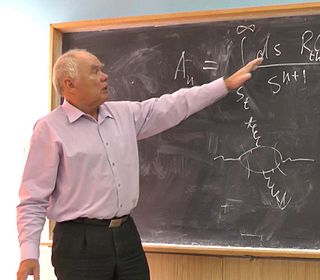
A gluon is an elementary particle that acts as the exchange particle for the strong force between quarks. It is analogous to the exchange of photons in the electromagnetic force between two charged particles. Gluons bind quarks together, forming hadrons such as protons and neutrons.

In theoretical physics, quantum chromodynamics (QCD) is the theory of the strong interaction between quarks mediated by gluons. Quarks are fundamental particles that make up composite hadrons such as the proton, neutron and pion. QCD is a type of quantum field theory called a non-abelian gauge theory, with symmetry group SU(3). The QCD analog of electric charge is a property called color. Gluons are the force carriers of the theory, just as photons are for the electromagnetic force in quantum electrodynamics. The theory is an important part of the Standard Model of particle physics. A large body of experimental evidence for QCD has been gathered over the years.

In physics, lattice gauge theory is the study of gauge theories on a spacetime that has been discretized into a lattice.

Lattice QCD is a well-established non-perturbative approach to solving the quantum chromodynamics (QCD) theory of quarks and gluons. It is a lattice gauge theory formulated on a grid or lattice of points in space and time. When the size of the lattice is taken infinitely large and its sites infinitesimally close to each other, the continuum QCD is recovered.

Quintessential Player was a freeware, multi-format media player developed by Paul Quinn.

In particle physics, quarkonium is a flavorless meson whose constituents are a heavy quark and its own antiquark, making it both a neutral particle and its own antiparticle.
Quark matter or QCD matter refers to any of a number of hypothetical phases of matter whose degrees of freedom include quarks and gluons, of which the prominent example is quark-gluon plasma. Several series of conferences in 2019, 2020, and 2021 were devoted to this topic.
The QCD vacuum is the vacuum state of quantum chromodynamics (QCD). It is an example of a non-perturbative vacuum state, characterized by non-vanishing condensates such as the gluon condensate and the quark condensate in the complete theory which includes quarks. The presence of these condensates characterizes the confined phase of quark matter.

A jet is a narrow cone of hadrons and other particles produced by the hadronization of a quark or gluon in a particle physics or heavy ion experiment. Particles carrying a color charge, such as quarks, cannot exist in free form because of quantum chromodynamics (QCD) confinement which only allows for colorless states. When an object containing color charge fragments, each fragment carries away some of the color charge. In order to obey confinement, these fragments create other colored objects around them to form colorless objects. The ensemble of these objects is called a jet, since the fragments all tend to travel in the same direction, forming a narrow "jet" of particles. Jets are measured in particle detectors and studied in order to determine the properties of the original quarks.
Hadron spectroscopy is the subfield of particle physics that studies the masses and decays of hadrons. Hadron spectroscopy is also an important part of the new nuclear physics. The properties of hadrons are a consequence of a theory called quantum chromodynamics (QCD).
Christopher Tadeusz Czeslaw Sachrajda is a British physicist. He is a professor of physics at the University of Southampton since 1990.
In theoretical physics, super QCD is a supersymmetric gauge theory which resembles quantum chromodynamics (QCD) but contains additional particles and interactions which render it supersymmetric.
Quantum chromodynamics binding energy, gluon binding energy or chromodynamic binding energy is the energy binding quarks together into hadrons. It is the energy of the field of the strong force, which is mediated by gluons. Motion-energy and interaction-energy contribute most of the hadron's mass.

Victor Sergeevich Fadin is a Russian physicist, well known for his contributions to theoretical physics and particle physics. He is a principal researcher at Budker Institute of Nuclear Physics (BINP) and professor of theoretical physics at Novosibirsk State University (NSU).
John Clayton Taylor is a British mathematical physicist. He is an Emeritus Professor of Mathematical Physics at the Department of Applied Mathematics and Theoretical Physics of the University of Cambridge and an Emeritus Fellow of Robinson College. He is the father of mathematician Richard Taylor.
The quantum vacuum state or simply quantum vacuum refers to the quantum state with the lowest possible energy.

The Quintessential Quintuplets is a Japanese manga series written and illustrated by Negi Haruba. It was serialized in Kodansha's Weekly Shōnen Magazine from August 2017 to February 2020, with its chapters collected into fourteen tankōbon volumes. The series follows the daily life of a high school student Futaro Uesugi, who is hired as a private tutor for a group of identical quintuplets: Ichika, Nino, Miku, Yotsuba, and Itsuki Nakano. At the very beginning of the story, it is shown that the events are being told in a flashback, while an adult Futaro prepares to marry one of the Nakano Quintuplets whose identity is only revealed near the end of the series.
Lance Jenkins Dixon is an American theoretical particle physicist. He is a professor in the SLAC Theory Group at the Stanford Linear Accelerator Center (SLAC) at Stanford University.
This page is based on this
Wikipedia article Text is available under the
CC BY-SA 4.0 license; additional terms may apply.
Images, videos and audio are available under their respective licenses.






